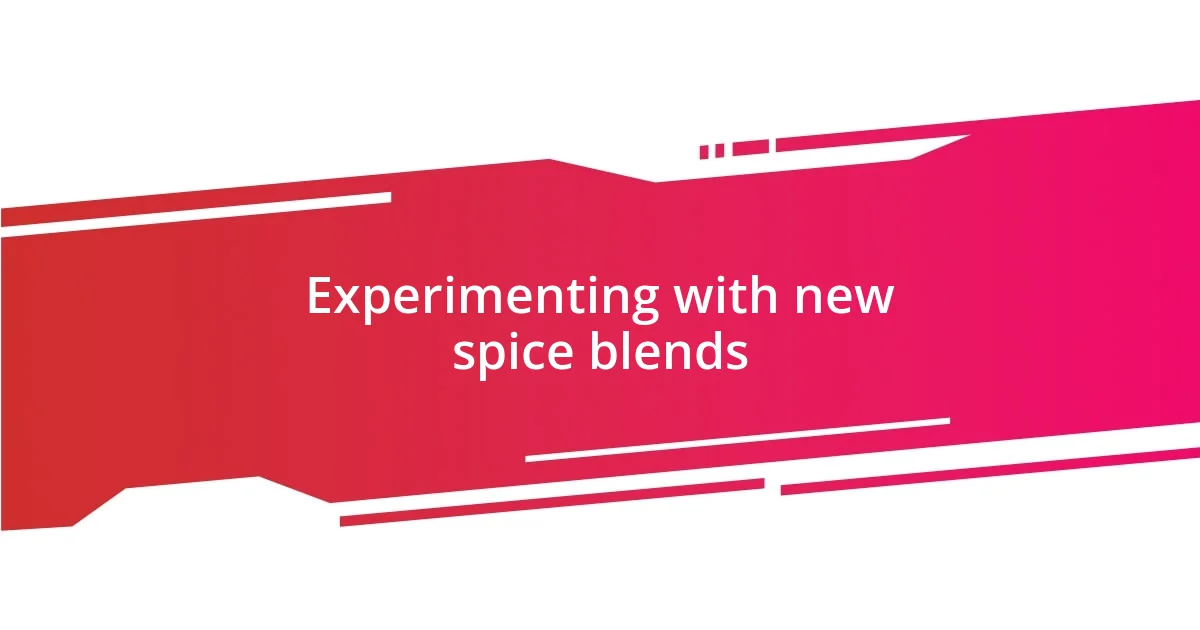Key takeaways:
- Understanding spices’ potency is crucial; a small amount can enhance flavor, while excess can overwhelm.
- Preparation techniques like toasting and proper infusion methods significantly affect the final brew’s quality and flavor profile.
- Experimenting with spice blends encourages creativity, but simplicity often leads to a more harmonious and enjoyable drinking experience.

Understanding spices in brewing
Spices bring a unique character to brewing that transforms an ordinary beverage into an extraordinary experience. I remember the first time I added cinnamon sticks to a stout; it was as if the beer suddenly came alive, wrapping its flavor around me in a warm embrace. Have you ever considered how something as simple as a pinch of spice can elevate your brewing game?
When brewing with spices, it’s essential to understand their potency. Some spices, like cloves or nutmeg, can easily overwhelm if added in excess, while others, such as ginger, can provide a subtle kick that rounds out the flavor. I once overdid it with black pepper and learned that a little restraint can go a long way. What lessons have you learned from your own experimenting?
Incorporating spices isn’t just about flavor; it also taps into the emotional resonance of memories and traditions. For instance, the aroma of cardamom in a brew can transport me back to my grandmother’s kitchen, where she lovingly prepared holiday treats. This personal connection makes the brewing process not just an art but a craft steeped in nostalgia and meaning. Have you ever had a spice remind you of a special moment?

Choosing the right spices
Choosing the right spices can feel overwhelming, especially given the vast array available. I’ve often turned to trusted favorites like coriander or star anise, but I also find delight in exploring the unconventional. Recently, I experimented with smoked paprika in a brown ale, and the result was nothing short of revelatory. It made me realize that the right spice can add layers of complexity I didn’t know were possible.
When considering spices, think about the overall profile of the beer you’re brewing. Light, fruity beers may pair well with delicate spices like lemongrass, while darker and richer brews might benefit from the warmth of cinnamon or allspice. I once paired a light lager with chamomile—a combination I continue to cherish. It’s amazing how spice choice can either enhance or clash with the beer’s natural flavor, so always trust your palate.
To guide your selections, I find that creating a simple comparison helps clarify which spices work best for your brewing goals. Having tried multiple combinations over time, I’ve noticed patterns in what does and doesn’t work harmoniously together. Here’s a useful table that summarizes some common spices and their ideal pairings:
| Spice | Ideal Beer Style |
|---|---|
| Cinnamon | Stouts, Porters |
| Ginger | IPAs, Lagers |
| Cardamom | Wheat Beers, Sours |
| Star Anise | Brown Ales |

Preparing spices for brewing
Preparing spices for brewing is a crucial step that shouldn’t be overlooked. I’ve often found that the way I prepare spices can significantly impact the final brew. For instance, when I decided to toast some coriander seeds before adding them to a batch, the aroma transformed beautifully, releasing a rich, nutty flavor that simply can’t be achieved with raw spices. It’s a simple technique, but one that can elevate the experience immensely.
Here’s a quick guide to help you prepare your spices effectively:
- Toasting: Lightly toast whole spices in a dry pan for a few minutes to bring out their essential oils.
- Grinding: For the best flavor, grind whole spices just before use. Freshly ground spices are more potent and aromatic.
- Infusion: Consider steeping whole spices in hot water before adding them to your brew. This allows for better control over flavor intensity.
- Timing: Add spices at different stages of brewing. For lighter notes, add them during the last 10-15 minutes of the boil, while heartier spices can go in earlier.
- Quantity: Start small! It’s easier to add more than to try and balance out an overpowering flavor.
These straightforward techniques have made a world of difference in my brewing. The joyful experimentation with spices—and witnessing their transformation in the brewing process—has turned each batch into a personal adventure that I never tire of. Embrace these methods, and you might find your favorite brew waiting just around the corner.

Infusing spices into beer
Infusing spices into beer is more than just adding flavor; it’s about creating an experience that resonates with the senses. I vividly remember my first attempt with cardamom. I was nervous, unsure if its strong, aromatic profile would overwhelm the delicate wheat beer I was brewing. To my surprise, the cardamom’s warmth blended seamlessly, giving the beer a delightful complexity that transported me back to my favorite chai tea moments. Have you ever had a similar revelation? It’s like discovering a hidden pathway to a whole new world of taste!
The method of infusion can vary widely, and I’ve experimented with several approaches. One time, I decided to create a spiced pumpkin ale by infusing spices like nutmeg and cloves in a secondary fermenter. The result was a perfectly balanced brew that felt like autumn in a glass. I learned that allowing spices to steep for several days really mellowed the flavors, creating a more harmonious blend. This patience during the infusion process taught me a valuable lesson: sometimes, great things take time.
In my brewing journey, I’ve observed that the timing of adding spices is crucial to achieving the desired flavor profile. During one brew day, I accidentally added too much ginger too early, resulting in a beer that was overwhelmingly spicy—think ginger shot rather than a refreshing ale! That experience was a swift reminder to approach spice addition with intention. I now carefully experiment with different stages, knowing that a sprinkle here or a dash there can make all the difference in the final taste. When have you felt the thrill of discovery in your own brewing experiments?

Balancing flavors with spices
Finding the right balance with spices can sometimes feel like walking a tightrope. I recall one oak-infused porter where I was overly generous with vanilla beans—what started as a rich, smooth base soon turned into a cloying dessert. Have you ever had a brew that surprised you in a not-so-good way? In that moment, I realized that spices should enhance, not overpower. Now, I aim for a delicate dance between the main flavors and the spices, allowing each element to contribute without overshadowing the others.
One of my go-to strategies has become making spice blends tailored to specific beer styles. For instance, I once crafted a blend for a Belgian witbier, combining coriander and orange peel. The result was a fresh, citrusy burst that brightened the beer beautifully. Do you ever find specific combinations that ignite your creativity? I believe it’s essential to consider how spices interact with the base ingredients. Learning the nuances of flavor interaction transforms each brew day into a learning experience, offering new insights into what works and what doesn’t.
I also pay close attention to the intensity of spices throughout the brewing process. I remember an instance where I steeped star anise for too long. The final brew had a potent, licorice-like flavor that was polarizing; people either loved it or absolutely hated it! Have you ever crafted something too bold for your own taste? That taught me to approach spice intensity with caution, understanding that subtlety can often yield a more complex and enjoyable flavor profile. Balancing flavors is truly an art, and every batch offers a new canvas.

Common pitfalls to avoid
One common pitfall I’ve noticed is the tendency to underestimate the potency of spices. During one of my early experiments with brewing a ginger-infused pale ale, I threw in what I thought was a generous amount of fresh ginger. What I didn’t expect was how the spice intensified during fermentation, leading to an end product that was intensely fiery—more hot sauce than refreshingly zesty. Has a miscalculation in your brew ever led you to rethink the power of your ingredients? It really highlighted for me that sometimes, less truly is more when it comes to spices.
Another mistake I often see is not paying enough attention to the infusion method. In my quest to create a chai-inspired stout, I decided to toss in some spices directly into the kettle. It didn’t dawn on me until later that the boiling process extracted the flavors too aggressively, leaving me with a murky, bitter brew. Have you ever needed to salvage a flavor gone wrong? It reinforced my belief that the brewing process can either amplify or dull the spices, depending on how you decide to incorporate them. Now, I meticulously research and choose the best infusion method for each spice, which has become an essential part of my brewing routine.
Lastly, I’ve stumbled upon the risk of trying to combine too many spices at once. Early on, I crafted a winter ale that included cardamom, cinnamon, clove, and nutmeg, all in one go. While I was aiming for a cozy blend, the end result was a chaotic clash rather than a harmonious union. How often do we throw in everything but the kitchen sink, hoping for magic? That experience taught me the importance of simplicity. Focusing on just one or two spices allows each to shine without stepping on each other’s toes, creating a more cohesive and enjoyable flavor experience. Embracing simplicity in spice blending has transformed my brewing and opened new avenues for creativity.

Experimenting with new spice blends
Experimenting with new spice blends has become one of the most exciting parts of my brewing journey. I remember one day, feeling particularly adventurous, I blended nutmeg, cardamom, and a hint of cinnamon into a stout. When I took my first sip, the flavors danced together seamlessly, creating a warm, inviting aroma that wrapped around me like a comforting blanket. Have you ever experienced those moments where a risk pays off beyond your expectations? It’s these delightful surprises that keep me motivated to explore new combinations.
As I delved deeper into mixing flavors, I found that keeping a detailed brewing journal made a world of difference. Not only did it help with remembering what worked and what didn’t, but it also allowed me to reflect on my evolving palate. One entry that stands out is the time I crafted a spiced pumpkin ale, using cloves and allspice. I aimed for a fall-inspired brew, and the aroma wafting through my kitchen was intoxicating! It taught me how certain spices evoke memories and emotions, creating not just a beverage but a whole experience. How can a simple blend transform a moment for you?
Now, I embrace the element of trial and error wholeheartedly. Rather than getting discouraged when things don’t turn out as planned, I see every misstep as a stepping stone to something greater. I recall brewing a stout with a bizarre combination of chili powder and espresso. The result was, let’s say, less than ideal—spicy coffee anyone? But that particular disaster taught me the value of moderation and balance. It reminds me that every blend I venture into offers a chance to discover not only new flavors but new aspects of my brewing identity. Have you had that moment when a blend pushed your boundaries? Those lessons are invaluable, and they fuel my passion for crafting something unique every time.















